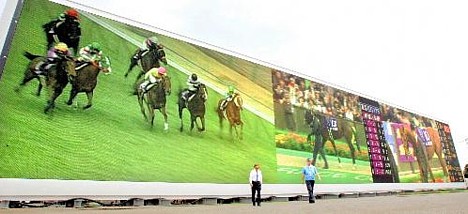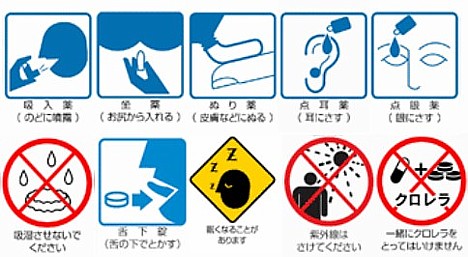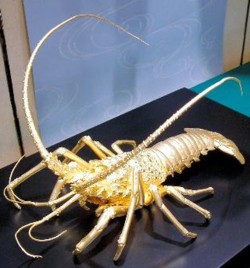Animated videos from Denki Groove's Nisenyon Summer ("Summer 2004") DVD.
Mr. Empty, followed by Chuunen Punk ("Middle-aged Punk")
Hikenai Gitaa O Hikun Da Ze ("Play The Guitar You Can't Play")
Animated videos from Denki Groove's Nisenyon Summer ("Summer 2004") DVD.
Mr. Empty, followed by Chuunen Punk ("Middle-aged Punk")
Hikenai Gitaa O Hikun Da Ze ("Play The Guitar You Can't Play")
 A mutant tomato with a face resembling a Chinese lion mask was harvested from a field in the city of Yahata in Kyoto prefecture. The common momotaro tomato is 3 times the normal size, measuring 10 cm in diameter and weighing 150 grams.
A mutant tomato with a face resembling a Chinese lion mask was harvested from a field in the city of Yahata in Kyoto prefecture. The common momotaro tomato is 3 times the normal size, measuring 10 cm in diameter and weighing 150 grams.
The unusually long rainy season is believed to have caused the fruit to absorb too much moisture.
The surprised farmer, who has been raising tomatoes for more than 30 years, says, "It's the first time I've ever seen a tomato with a fully formed face."
No word yet on how it tastes.

(Spoo's tomato cousin?)
[Source: Mainichi Shimbun]

Mitsubishi Electric has completed construction of the world's largest high-definition video screen at a horse track in Tokyo. The screen employs Mitsubishi's Aurora Vision LED technology and measures 11.2 meters (37 feet) x 66.4 meters (218 feet), giving it a surface area of 744 square meters (8,000+ square feet), or the equivalent of 3 tennis courts. Mitsubishi manufactured the screen for the Japan Racing Association (JRA) at its Nagasaki factory in the town of Togitsu, Nagasaki prefecture. The screen was divided into 35 pieces for delivery to the Tokyo Racecourse in Fuchu, Tokyo.
The bright, high-definition display is 3 times larger than what was previously installed at the horse track, and the screen's three sections allow the audience to take in the action at other tracks. Total cost is reported to be 3.2 billion yen (US$28 million).
[Source: Asahi Shimbun]
==========
UPDATE: Check out this Fuji TV news report on YouTube. The video shows an athletic reporter sprinting from one end of the 2,651-inch monster to the other (in 12.8 seconds). You'd have to stack 1,550 32-inch TVs to match the size of this screen. [Via: TV in Japan]
 Researchers at Akishima Laboratories (Mitsui Zosen), working in conjunction with professor Shigeru Naito of Osaka University, have developed a device that uses waves to draw text and pictures on the surface of water.
Researchers at Akishima Laboratories (Mitsui Zosen), working in conjunction with professor Shigeru Naito of Osaka University, have developed a device that uses waves to draw text and pictures on the surface of water.
The device, called AMOEBA (Advanced Multiple Organized Experimental Basin), consists of 50 water wave generators encircling a cylindrical tank 1.6 meters in diameter and 30 cm deep (about the size of a backyard kiddie pool). The wave generators move up and down in controlled motions to simultaneously produce a number of cylindrical waves that act as pixels. The pixels, which measure 10 cm in diameter and 4 cm in height, are combined to form lines and shapes. AMOEBA is capable of spelling out the entire roman alphabet, as well as some simple kanji characters. Each letter or picture remains on the water surface only for a moment, but they can be produced in succession on the surface every 3 seconds.
Researchers at Akishima Laboratories have developed similar devices in the past that used waves to draw pictures on the surface of water, but those devices had trouble producing letters with straight lines (such as the letter K). Additionally, it took the previous devices up to 15 minutes of data input time to produce each letter.
The newly developed technology uses improved calculation methods for controlling the wave generators, relying on formulas known as Bessel functions. In addition to being able to draw letters consisting of straight lines, the input time has been drastically reduced to between 15 and 30 seconds for each letter.
Akishima Laboratories expects the technology to be incorporated into amusement devices that combine acoustics, lighting and fountain technology, which they hope to see installed at theme parks and hotels.
====================
UPDATE Dec 27, 2006: Check out this short video of AMOEBA in action, from the World Business Satellite (WBS) news program (props to Seihin World). AMOEBA forms the letters "WBS" on the water surface.
[Source: Fuji Sankei]
 There is a mailbox located underwater off the coast of Susami in Wakayama prefecture.
There is a mailbox located underwater off the coast of Susami in Wakayama prefecture.
The mailbox is not some old sunken relic, but an actual mail collection point officially recognized as part of Susami's postal system.
Each day the contents are collected from the box, which reportedly contains as many as 200 pieces of mail at the busiest times.
[Source: Jiji]
 Geminoid is a remote-control doppelganger droid designed by and modeled after Hiroshi Ishiguro, professor at Osaka University and researcher at ATR Intelligent Robotics and Communication Laboratories. Robot Watch has released some short videos, which you can see at the links below. Video format is WMV.
Geminoid is a remote-control doppelganger droid designed by and modeled after Hiroshi Ishiguro, professor at Osaka University and researcher at ATR Intelligent Robotics and Communication Laboratories. Robot Watch has released some short videos, which you can see at the links below. Video format is WMV.
Video 1: Ishiguro introduces himself through Geminoid.
Video 2: This segment shows Geminoid's facial movements. The telepresent Ishiguro explains, "When someone touches Geminoid, it seems as if I am the one being touched."
Video 3: Geminoid (Ishiguro) doesn't like it when you touch his face.
Video 4: Geminoid is programmed so that his head continues to move, even when not being specifically controlled.
Video 5: Sitting next to Geminoid, Ishiguro discusses his research concerning "presence."
In Latin, gemin means "twin" or "double," while -oid is a suffix indicating a "likeness to something else." Hiroshi Ishiguro would say that his Geminoid is like a twin. The body is a copy of Ishiguro's, and the shape of Geminoid's skull was created based on MRI scans of Ishiguro's head. And Geminoid shares some of his mannerisms.
Geminoid's body, which was produced by Kokoro, makers of the Actroid line of fembots, has 46 degrees of freedom and is driven by a system of air compressors. The skin consists of soft, silicone rubber. Confined to a chair at the moment, the android is unable to stand up and move about on his own. Communication and power cables exit his rear end and snake through the shaft of the chair out of sight. It took 6 months of work to develop the body and about 2 to 3 months to develop the software.
One of the purposes for creating Geminoid is to explore the concept of tele-existence -- to figure out what is needed in order to copy an actual human's "presence" so that he or she may exist in two places at once. "I wonder how possible it is to separate one's inner self and outer self, to create distance between one's body and soul," Ishiguro says.
See more photos of Geminoid at the link below.
[Source: Robot Watch]
The Risk/Benefit Assessment of Drugs-Analysis and Response (RAD-AR) Council of Japan has released a new batch of pictograms for use on pharmaceutical packaging. No more deciphering complicated dosage directions and warnings -- a glance is all it takes now.

Get your copy of all 51 pictograms here.
[Via Iza!]
 In squid-crazy Hakodate, squid fishing is big business, the local specialties include shio ramen (squid-topped ramen) and ikasomen (raw squid cut into the shape of somen noodles), the summer festivals have residents busting squid-like moves in a dance called ika-odori (a squirmy version of the traditional bon dance performed at summer festivals throughout Japan), and the city fish is the squid. It is therefore unlikely that anyone was surprised when, on July 18, a group of Hakodate residents made an official announcement regarding plans to create a giant robotic squid for the city.
In squid-crazy Hakodate, squid fishing is big business, the local specialties include shio ramen (squid-topped ramen) and ikasomen (raw squid cut into the shape of somen noodles), the summer festivals have residents busting squid-like moves in a dance called ika-odori (a squirmy version of the traditional bon dance performed at summer festivals throughout Japan), and the city fish is the squid. It is therefore unlikely that anyone was surprised when, on July 18, a group of Hakodate residents made an official announcement regarding plans to create a giant robotic squid for the city.
The citizens' group, called "Robot Festival in Hakodate," aims to create a new symbol for Hakodate, one of the leading tourist destinations in Hokkaido -- and what better symbol than a giant robotic version of the city's favorite creature?
Members of the group include university professors specializing in robotic engineering, who will work to incorporate cutting-edge technology that will allow the robot to be controlled remotely via the Internet. Development will be led by Hitoshi Matsubara and Hidekatsu Yanagi, information architecture professors at the School of System Information Science at Future University-Hakodate (FUN). Matsubara will handle the robotics research and development, while Yanagi will handle design. Students from the university, along with Hakodate high school teachers and students and others in the local manufacturing industry, will contribute ideas in brainstorming sessions.
The group has chosen "light" as the design theme for the robot -- a choice based on the night view from Mt. Hakodate, a popular local tourist attraction where visitors can marvel at the twinkling lights of the city and squid fishing boats offshore. In line with this theme, the entire body of squid robot will be covered in lights that blink as the robot moves. In addition, the robot will be equipped with a set of wireless receivers and will have its own homepage featuring a set of controls that allow remote users to move the robot's tentacles and eyes.
The developers plan for the robot to stand 5 meters (16 feet) in height. After an intial 1.5-meter prototype is completed this November, work will begin on the larger final version, which the group aims to unveil in a parade at the Hakodate Port Festival in the summer of 2007.
Masao Fujii, chairman of the citizens' group, says, "We hope to create a high-quality robot that attracts a lot of attention and makes people want to come to Hakodate."
The total cost of the robot is expected to be somewhere in the 30 million yen range (US$250,000). The group hopes to cover much of that cost with membership fees, so they are now recruiting members.
[Source: Hokkaido Shimbun]
 A golden lobster has been placed on display at the Ginza Tanaka jewelry store in Nagoya.
A golden lobster has been placed on display at the Ginza Tanaka jewelry store in Nagoya.
Crafted from 500 grams (1.1 lb.) of pure gold, the creature is a detailed life-sized reproduction of an Ise-ebi lobster (Japanese spiny lobster, or Panulirus japonicus). It measures 34 cm (13 in.) long and 19 cm (7 in.) tall. The asking price is 5 million yen (about US$40,000).
Ise-ebi lobsters are often bestowed as gifts on special occasions in Japan. According to a shop attendant, this golden crustacean can serve as both a celebratory offering and a good luck talisman.
Customers react in various ways when they see the realistic-looking golden lobster. Some of them say they expect it to start moving, while others say it looks delicious.
[Source: Asahi Shimbun]